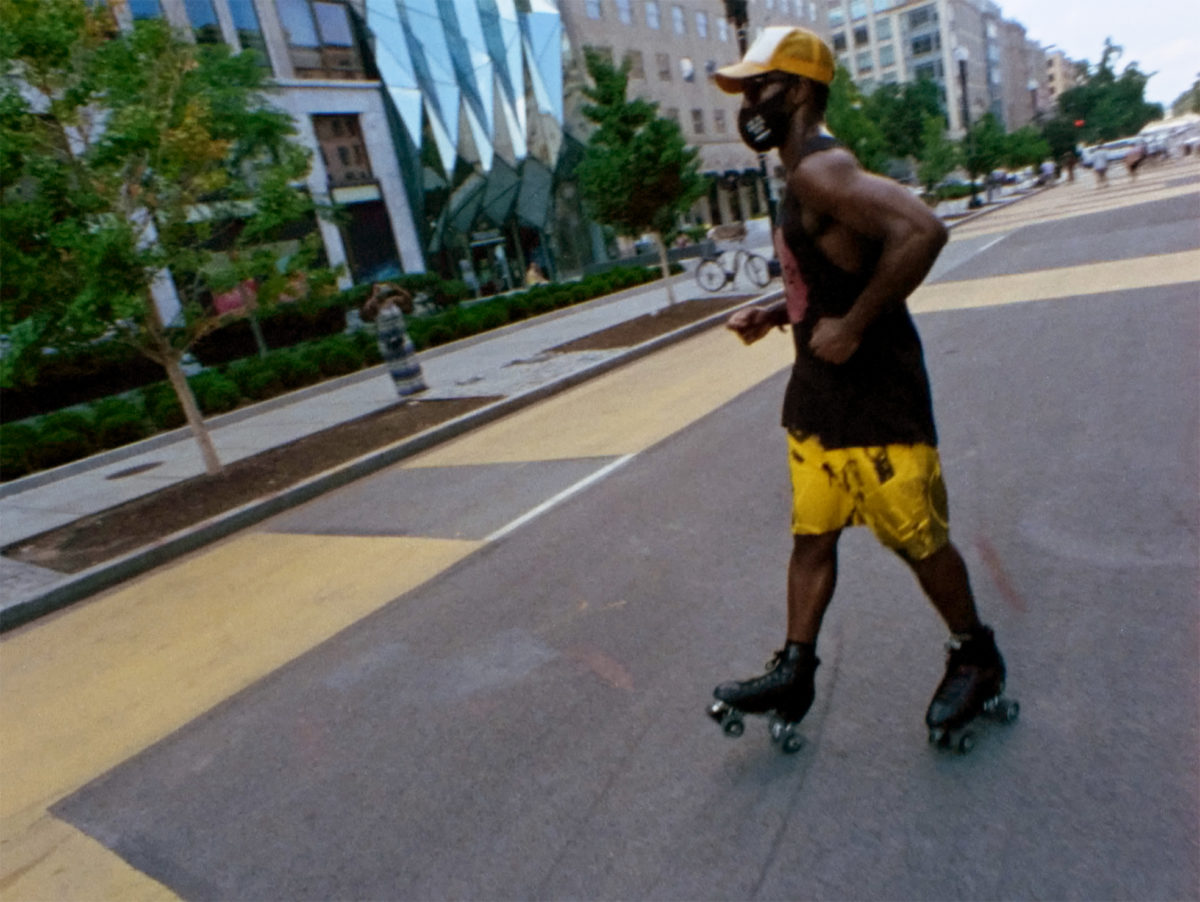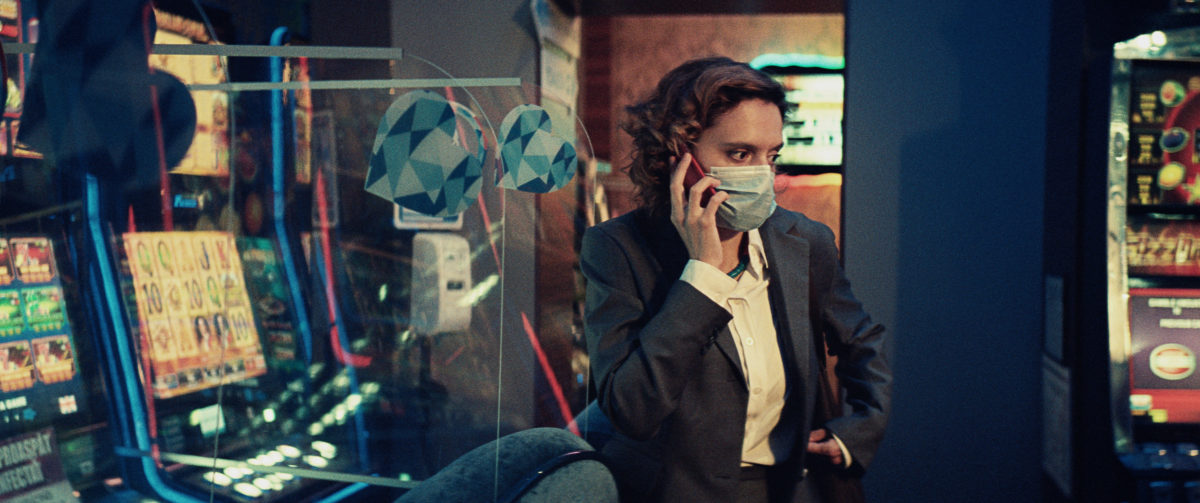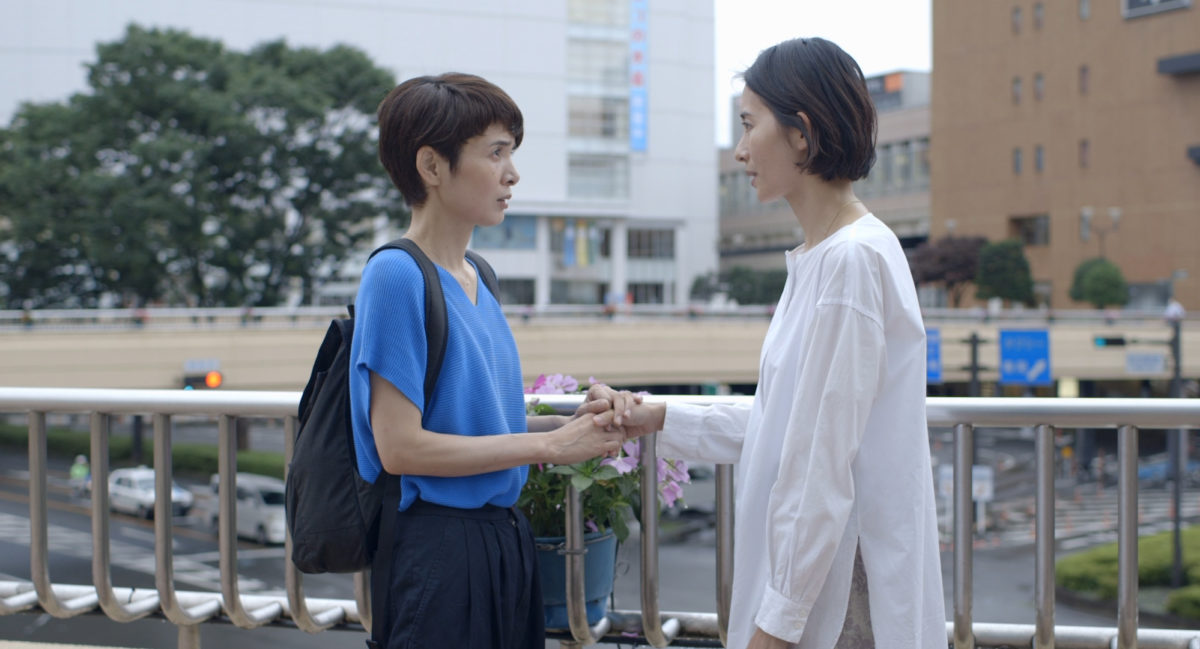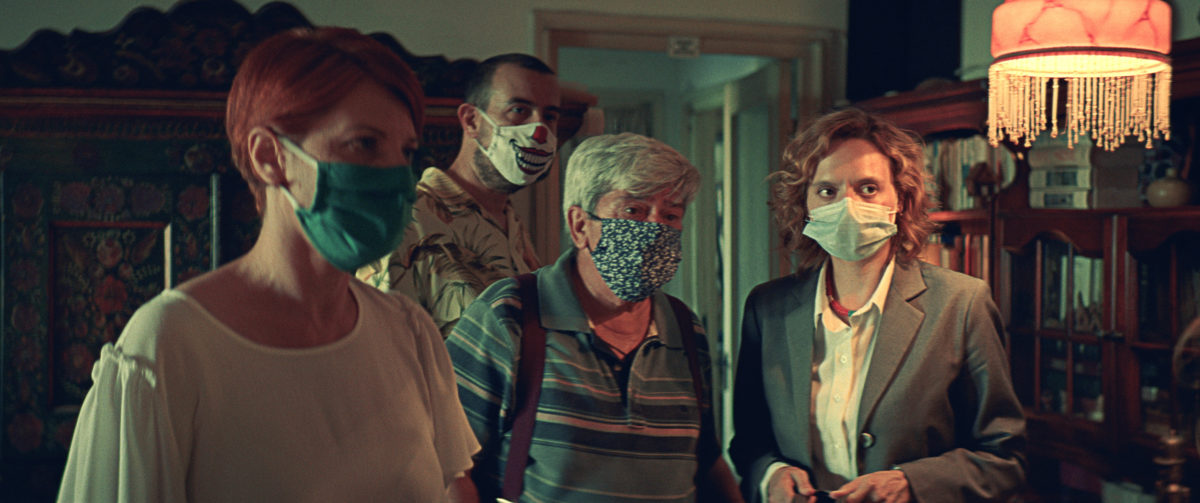While most of us have spent the last year firmly rooted in our homes and their vicinities, the unstoppable movie machine has barreled forward, with press releases announcing everything from Robert Pattinson catching Covid shooting a new Batman picture to the apparent existence of a ‘Casablanca franchise’. This Hollywood end of the spectrum carries on with a fixation on the hyperreal, unwilling to relent or admit even just a short break in the face of a planet-spanning deadly pandemic—in fact, this is the perfect time to strike, while a captive audience is stuck at home—and none of such productions seem willing to be set in the reality of 2020, with its smile-covering masks and constant threats of disease. This unwillingness to depict a reality from the time in which a film was made means the opening of an alternate reality, one which we are supposed to accept, despite the fact that such a vision of the world onscreen is inevitably divorced from the present moment. It’s true that the reality depicted on screen has always been an alternate one, running in some kind of parallel alongside our own. Yet this new parallel screen reality now takes a more radical departure in that it does so unknowingly. Where a certain franchise always opens with a marker of its location in space-time to acknowledge the alternate reality it presents (“a long long time ago”, etc.), and where a film such as Uncut Gems (2019) was deliberately set in 2012, most new films shot ‘during Covid’ offer no such guideposts. To a degree, and to use a tired phrase, new films seen over the last year are our windows to the outside world. Whether we accept it or not, our memory of the world beyond our own city is shaped by these images.
Television and the cinema exist on a different level of reality than caves or Etruscan graves. The older magic is pre-historical and antedates historical consciousness; the newer magic is post-historical and succeeds historical consciousness. The old witchcraft aims at changing the world out there; the new aims at changing our concepts concerning the world out there.
— Vilém Flusser, Towards a Philosophy of Photography (1984), p. 12
On the other end of the spectrum, I found myself wondering when independent productions (or lower budgeted European productions) might have the courage to set their story in 2020 as we experienced it, or at least admit the situation to a degree. Given the slate of films only coming out now that had been shot in the preceding years, there might yet be a bevy of ‘masked films’ on the horizon—though I doubt it. For the time being, three Berlinale titles have decided to address the current moment in their own ways.
Technical images thus suck all of history into their surfaces, and they come to constitute an eternally rotating memory of society. […]
Everything desires to flow into this eternal memory, and to become eternally reproducible there. Every event aims at reaching the television or cinema screen or at becoming a photograph. Or, if the event does not openly admit its availability, it at least glances surreptitiously in that direction. The result is that every event or action loses its proper historical character, tending to become a magic ritual, an eternally repeated motion.
— p.14

Kevin Jerome Everson’s (or keverson, as it always appears in the end credits) may june july is among his strongest engagements with the short form to date, and seemingly comprises of material shot in those months of last year. The first shot features a diagonal divide through the screen, cutting it into thick yellow paint and gray concrete. Rollerblades weave in and out of the frame. Then close-ups on flowers in the dark of night, crickets chirping, flowers lit individually by flashlight, some just beginning to bloom, others already wilting. In a brilliant moment of a pitch-black screen, there is a flashing presence of fireflies, bright specks on a Stygian canvas. Then back to the rollerblading (black) man (Jahleel Gardner)—who we now see is masked—dancing around the yellow paint, revealed to be the massive ‘I’ and ‘V’ in ‘BLACK LIVES MATTER’. Eventually he skates to the ‘ES’, as the soundtrack moves from its consistent street drum track to the distant call-and-response rhythmic chants of the written words made audible: “black lives matter.” Thus Everson melds two distinct realities: that of the human-free quiet of the night and the firmly-set-in-the-summer-of-2020 streets of Washington, D.C. And though I haven’t yet seen it, he seems to take this idea of ‘two distinct realities’ a step further with his newest film, the i and s of lives, which recently premiered as part of Cinema du Réel and features the exact same clip as a trailer. With a runtime difference of a single minute, one wonders if it is the same film with the night scenes removed, an alternate reality version of his own work.

After a bout of homemade coitus-on-tape, Radu Jude’s Golden Bear-winning Bad Luck Banging or Loony Porn begins ‘proper’ on the streets of Bucharest, dotted with the conspicuous presence of facemasks (as well as the realistic drove of folks who fail to cover their noses or forego the mask entirely). Of the decision to include masks in the film, Jude offers two deciding factors in the press kit:
Firstly, because the film was supposed to be contemporary and the masks were part of our daily life and I wanted to capture this moment, to find the anthropological aspect of the mask-wearing. Secondly, because I cared about the health of the people involved.
And later, on this “anthropological aspect,” he offers:
If you went down on the street during this time, the signs that remained—posters for concerts, empty restaurants, and so on and so forth—were already signs of a non-existent reality. Cinema has this possibility to capture things, to capture the signs of the time passing, to make a capsule of the moment in many ways.
All the same, the film juxtaposes this ‘realism’ of masks in the summer of 2020 with a satirically heightened reality, near-caricatures voicing conservatively human concerns in the ‘trial’ that comprises the film’s climax. Bad Luck Banging is presented as a triptych, with opening and closing chapters set in our current reality bookending a visual lexicon rolling alphabetically through a collection of words amassing something like Jude’s vision of modern Romania—kitchen, Christmas, Metaphor, Montage—gradually relating them back into one another; a slowly developing narrative about the injustices of the entire country, historically and currently. “Children—political prisoners of their parents.” We return again and again to WWII and the 1989 Romanian revolution, radical historical upheavals that have become itemized and neutralized through their commodification—‘French Revolution’ is now merely a brand of éclair, and ‘Revolution 1989’ nothing more than a bottle of wine. Each single word is elaborated upon through silent subtitles, only occasionally accompanied by a voice, e.g. “Justification—pigs were given to us by god to eat.” Thus we are driven through a history of the ways in which capital constructs its alternate version of history.

Ryusuke Hamaguchi’s Wheel of Fortune and Fantasy—also a triptych—approached this ‘issue’ of depicting the current moment in its third chapter, ‘Once Again’, by inverting reality. While there are no facemasks present, the shooting of the segment solves practical issues by focusing largely on two actresses—a minimal approach which nearly applies to the rest of the film anyway—and an opening text explanation: a digital virus rather than biological one. A utopian inversion of the real-life virus, Hamaguchi imagines a world attacked by a computer virus which sends one’s most private digital files to anyone else virtually connected, leading humanity to abandon their computers, and bringing people back not only to physical media—one of the characters has a son who has ordered a Blu-ray of anime coming in the mail, yet one does wonder how he went about ordering it (by phone I suppose?)—but the physical world, and physical presence. I think the best way to picture this part of Wheel of Fortune and Fantasy is to imagine if I could share these thoughts with you out loud in a room with just the two of us, rather than typing them into my screen—the same screen I used to watch this year’s festival offerings, often connected or projected to another, larger screen, this same screen which has hosted my home’s cinematic offerings over the last year—for your later retrieval on a separate screen. As in his previous Asako I & II (2018), Hamaguchi focuses on relationships, and the ways we imagine what could have come to pass; how things did happen forever alters the way we consider their alternate possibilities in retrospect.
Even ignoring all these cues, an unavoidable one comes from the festival’s very existence in a virtual form. Even if only for press and industry, this version of a ‘festival’ is basically just ‘binge watching’. The internet has become that “eternally rotating memory of society,” an alternate reality we continue to live inside of. One hopes it will remember what life was like then and now. In all honesty, though I offer my interpretation of them, I cannot claim to have truly seen these films. I have more or less ‘extracted their content’, for now. Even the idea of watching such a large volume of films over a mere five days proved challenging on its own; trying to contemplate these works in my own living room under the pressure of such a window of time became a chore. Despite my excitement to watch certain titles, it was with a distinct sense of dread that I continued to push forward, trying to grab extra screeners here and there to catch up with a few titles even after this window of five days. To be frank, I hate the virtual festival for press. It is an alternate reality I would rather not engage with. I can’t help but keep requesting press passes for fear of missing some vital new title, but what’s the use if I can no longer enjoy watching such films properly? And why should this new virtual model mean compressing time more than ever (five days instead of the usual in-person ten), rather than taking the opportunity to stretch out a bit? Perhaps offer viewers the possibility to do the five-day festival or a five-week equivalent, where each of the five days’ titles would be available for a full week instead of a day? I have in fact failed to incorporate into this essay the film which most grabbed my attention this year—Ste. Anne, a daring and beautiful little picture shot on 16mm which made me miss the cinema space like no new title has—precisely because it was not streaming until the fourth day of the festival, by which time I felt my nerves wearing thin. Simply put, I was not able to give that film the time or attention I would normally relish spending in such a way. Maybe I’m just not cut out for ‘this business’, but maybe we should re-evaluate the entire ‘virtual festival’ structure that has emerged and begun to push ahead with a vehemence which parallels the ceaseless Hollywood machine.
And yes! I absolutely started a ‘virtual film festival’ of my own last year, yet even those programs which came out a mere week apart remain as theoretical viewing schedules that someone might decide to embark upon on any given weekend in the future. And our two live-streamed programs were kept to only a half-hour runtime and put online for only 24 hours, in the hopes that one might be able to decide more simply, either: “yes, I will be dedicating 30 minutes of my Friday evening to this screening,” or, “no, I won’t manage to watch it in those particular 24 hours.” For me this is an easier decision than the looming infinite choices of a week-long stream, or festival, or what have you.
And though they were a full month apart, I was already dreading that the Berlinale had come so swiftly after IFFR. This always happens, and usually in closer temporal proximity, yet this virtual reality and the past are of course two different realities. I can understand how all of this could simply come off as a privileged individual (who has early access to brand new films!) whining about having it too good, but the simple truth is I wouldn’t wish such fear of missing a great title or stressed time-pressurized home viewing on anyone. The accessibility of the web has meant that what would have once been (micro-)screenings in person can be shared the world over all at once. The flipside to this is that we should never have so much access all at once. Small scale organizations now have the once-rare opportunity to reach a larger audience, yet the number of organizations vying for everyone’s attention has also increased tenfold. Just as the playing field has been supposedly ‘leveled’ to allow niche cinemas and renowned yet exclusive festivals alike to stream for geographically remote viewers, so too do major new blockbusters get transmitted directly to living rooms converted to first-run ‘cinemas’.
Effectively, the constant drive toward ‘productivity’ under capitalism has colonized what was once a refuge from the world outside; the peace of being at home. Sure, writing from home is not entirely new for most of us, but the way we interact with our ‘free’ time has undeniably changed. Everything is NOT FINE! Let’s stop pretending that it is.
